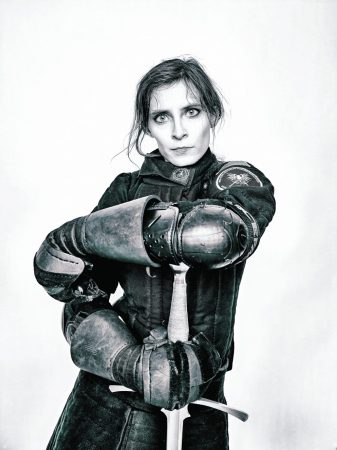
Woman warrior Laura McBride of the Fecht Club via The Village Voice©
Thorny perfume, thorny topic.
The fact that I feel drawn to perfumes of the 50s is unrelated to having been born into that era. Some of these fragrances feel like aromatic wish fulfillment and/or projection: despite the tyranny of long-line brassières and girdles (or possibly in light of their existence) there has always been a subtext of suppressed eroticism, the controlled sensuality of discipline akin to a warrior preparing for anticipated battle. Clearly defined 1950s gender roles makes this subversive quality all the more fascinating; today Cabochard de Gres reads as perfect for anyone who loves the impossibly dry elegance of a leathery tobacco-laden no-nonsense chypre.

Ida on Commonwealth Avenue in the snow, Winter 1984 (vintage Schiaparelli Persian lamb)
I once referred to Caron Poivre as the Miss Julie of perfumes; I believe whip-cracking was involved (enter Coup de Fouet). Former contributor Vanessa Musson had us rolling in the aisles with her brilliant approach/avoidance spin on Cabochard and Mr. Turin’s concise opinions on the subject (it was clearly not her chosen cup of tea). For me, Cabochard de Gres is neither dominatrix nor bête noire: it is warrior perfume and most welcome. I made its acquaintance in 1972 and have blown through innumerable bottles since. It scratched an itch I didn’t realize I had and felt instinctually fitting. The name arises from the French word caboche, and translates as willful or headstrong. Feel free to draw your own conclusions.
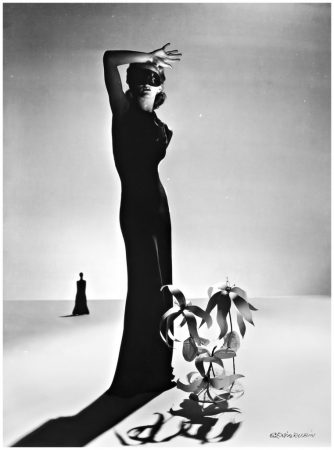
Lisa Fonssagrives wearing Alix Gres in Harper’s Bazaar
Cabochard was composed by illustrious Bernard Chant of IFF, renowned for Clinique Aromatics Elixir, Coty Imprevu, Halston Classic, Lauren for Ralph Lauren, Antonia’s Flowers, Aramis (several!), and gorgeous Lauder perfumes ( Aliage, Estée, Azurée, Cinnabar and Beautiful). Madame Alix Gres, haute couturière whose designs were cut on the human form itself – desired a perfume which evoked a desolate Indian beach she had visited in her travels. “The crispness of the early morning air, the warmth of sandalwood, a hint of far-off flowers, and the dry caress of sea breezes” – a rather tall order which I suspect wasn’t translated into fragrance as the designer had hoped.
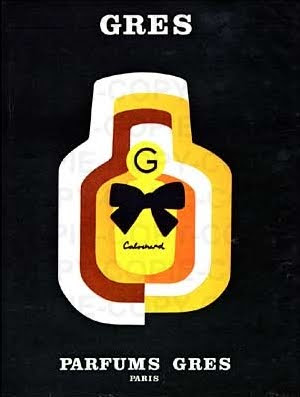
Parfums Gres Cabochard 1974 ad via The Non-Blonde (RIP Gaia)
It is said that Madame did not care for the perfume, but Cabochard was wildly successful at the time of its release. Many regard Cabochard as a smoother sibling of Piguet’s Bandit, which broke through gender barriers 15 years prior (in 1944), sporting its extravagant dosage of isobutyl quinoline (you will inevitably come across this your reading). While they share common threads, I compare them, side by side: Bandit is more bitterly verdant to my nose, with artemisia in tow alongside galbanum and there is nothing of the cigarette about its person. In contrast, Cabochard smells like a well-worn motorcycle jacket, cigarette tobacco dusted with flowers, rolled in moss and lolling about in sandalwood; it’s less green overall and an étude in aridity as opposed to Bandit’s moister environs. Neither will suit the faint of heart. I wouldn’t want to choose between them and I haven’t had to do so – but truthfully Cabochard might edge out Bandit, if it came down to vintage formulations. The sophisticated ferocity takes no prisoners in its self-aware stance as it coolly surveys the playing field. Bandit is for risk-takers and iconoclasts; Cabochard is for warriors.

Dr. Lilith Sternin in episode from Cheers
Warriors are fierce by nature – and it is that very word which made me bristle for most of my adult life. Women in particular would refer to me as ‘fierce’. Although this was intended as something positive, I was horrified: how could they??? I was all about peace and love and acceptance, avoiding conflict whenever possible. Didn’t I always have their backs? I felt deeply wounded, offended by the oft-repeated inference. Surely they were mistaken.
“Well, I started out on a dirty road
Started out all alone
And the sun went down as I crossed the hill
And the town lit up, the world got still
I’m learning to fly but I ain’t got wings
Coming down is the hardest thing.
Well, the good old days may not return
And the rocks might melt and the sea might burn…” ~ Learning to Fly by Tom Petty and Jeff Lynne
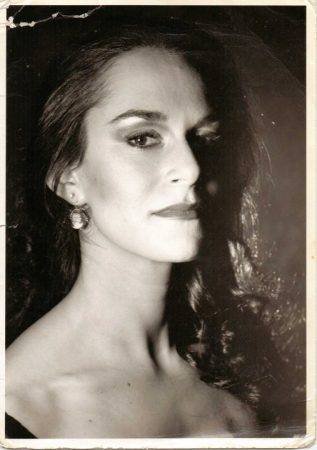
Ida’s resume photo for Boris Goldovsky 1981
What did others see in myself that I could not? Deep in my DNA, even in 1972 when I first discovered Cabochard, there existed a spirit which wouldn’t be subjugated, sublimated, vanquished: a warrior poised on the brink of never-ending skirmish. Gentle until no recourse remained but the dagger, willing to go to war for a noble cause, follow a leader worthy of the task. I don’t think I actually glimpsed that person until I had resumé photos taken in preparation for an audition with opera impresario Boris Goldovsky – and they frightened me. I avoided the camera. What I’d mistaken for ‘resting bitch face’ was pure resolve in the face of adversity and distrust of the lens’ scrutiny.
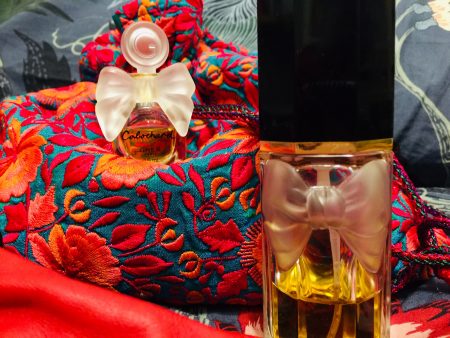
Cabochard parfum and eau de parfum from Ida’s collection ©
But life has other plans for us, and it is only over the past five years or so that I’ve come to make my peace with my Inner Warrior. I’ve stopped cringing at having been born under an Aries sun (Mars), feeling compelled to explain that my natal chart is well-balanced (if ill-fated) in response to being told how fierce I appear. I even purchased my warrior a dagger which I will wear until my last days, an early birthday present as a reminder of how it is not in my nature to give up against the odds even though the deck may be stacked. The warrior woman has been there since childhood, and the ease with which I slipped into Cabochard at 18 is one more proof.
Notes: bergamot, mandarin, galbanum, ylang ylang, jasmine, Bulgarian rose, clove, oakmoss, tobacco, musk, iris, sandalwood, vetiver, leather, castoreum, patchouli, labdanum
~ Ida Meister, Senior Editor and Natural Perfumery Editor
